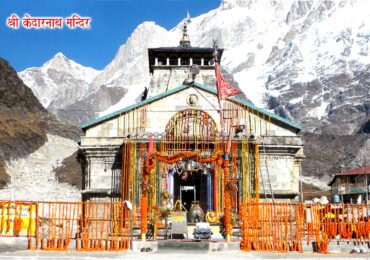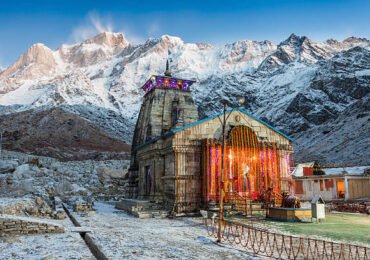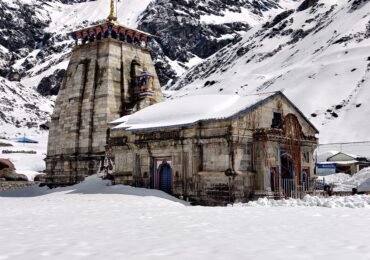No products in the cart.
 About Kedarnath
About KedarnathKedarnath is a small town nestled in the mid-hills of the Himalayan mountains in the state of Uttarakhand, located in northwestern India. Recognized as a sacred Hindu town, it holds significance as one of the stops on the Himalayan Char Dham pilgrimage. Positioned at an altitude of approximately 3584 meters above sea level, Kedarnath is situated near the origin of the Mandakini River, surrounded by awe-inspiring peaks.
During the early and late seasons, the paths can become frozen and slippery, with the temple and houses covered in a blanket of snow. The local residents, bundled up in multiple layers of clothing, can be found sipping tea at the teashop next to the temple. Sadhus, seeking warmth, set up camp on the streets, burning locally gathered wood.
Kedarnath is home to one of the holiest Hindu temples, attracting pilgrims and tourists from around the globe. Situated at the source of the Mandakini River, the Kedarnath shrine holds immense reverence among Hindu pilgrims.
To reach Kedarnath, one can embark on a 13 km trek through a hilly paved path (with options for renting horses or palanquins) from Gaurikund. Gaurikund is accessible by road and is a day’s travel from Rishikesh, Haridwar, Dehradun, and other prominent hill stations in the Garhwal and Kumaon regions of Uttarakhand.
As of the 2001 India census, Kedarnath had a population of 479.
Legend has it that during their Himalayan pilgrimage in the Mahabharata, the Pandavas sought to pay homage to Lord Shiva. However, Lord Shiva, aware of their guilt for killing their brethren (gotra hatya), was uninterested in meeting them. In response, the Lord transformed into a bull. Despite the disguise, the Pandavas saw through it. As the bull tried to disappear by diving into the ground, Bhima acted swiftly, grasping its hind legs and thwarting its escape. In the ensuing struggle, different parts of Lord Shiva’s body appeared at various locations in Kedarkhand. The bull’s hump surfaced at Kedarnath, playing a vital role in the Kedar legend. The Panch Kedar trek encompasses all five shrines associated with this legend, located in the Kedar Valley. Kedar is an alternate name for Lord Shiva, and it signifies the stone worn smooth by years of travel in the Ganges River. In the Chamoli district alone, there are over 200 shrines dedicated to Lord Shiva, with Kedarnath being one of the most significant and also one of the twelve Jyotirlingas of Lord Shiva.

As one approaches from Garurchatti, the Kedarnath temple becomes visible about 500 meters ahead. Against the backdrop of towering snow-clad mountains, the temple exudes a captivating charm. The surroundings are imbued with an aura of peace and purity, where the unholy are believed to attain holiness and the holy, even greater sanctity.
The temple, a magnificent specimen of architecture, stands on a morainic ridge extending at right angles from the snowy range. Constructed in the 8th century by Adi Shankaracharya, it stands adjacent to the site of an earlier temple built by the Pandavas. The inner walls of the assembly hall are adorned with depictions of various deities and scenes from Indian mythology. A large statue of the Nandi Bull stands guard outside the temple door. Crafted from immense, heavy, and evenly cut grey stone slabs, the temple sparks wonder about the methods employed in handling such weighty slabs in ancient times. The temple comprises a Garbha Griha for worship and a Mandap, ideal for gatherings of pilgrims. A conical rock formation within the temple is venerated as Lord Shiva in his Sadashiva form.
The temple remains closed from November to April due to severe weather conditions, with thick snow covering the site.
In addition to its association with Shiva, Kedarnath is believed to be the location of Shankaracharya’s samadhi.
No specific family of pujaris oversees the various rituals at Kedarnath.
The Kedarnath Temple is a famous Hindu temple located in the Rudraprayag district of the Uttarakhand state in India. Situated amidst the Himalayan range in the lap of the Godavari River, the Kedarnath Temple is one of the twelve Jyotirlingas and one of the Char Dhams and Panch Kedars. Due to the challenging climate, the temple is open for darshan (worship) only from April to November each year.

Constructed in the ancient Katyuri architectural style using stones, the temple is believed to have been built by Maharaja Janmejaya, the grandson of the Pandavas. The self-manifested Shiva Linga present here is highly revered. Adi Shankaracharya is credited with the renovation of this temple.
In June 2013, a devastating flood and landslide affected the Uttarakhand and Himachal Pradesh states in India, with Kedarnath being the most severely impacted area. Many surrounding structures were washed away, but the main temple and its centuries-old dome remained intact. The entrance gate and the surrounding area, however, were destroyed.
The construction of Kedarnath Temple has been the subject of various theories, ranging from its association with the Pandavas to Adi Shankaracharya. Scientific analysis suggests that the temple might have been built in the 8th century, but its existence spans at least 1200 years. The challenging terrain of Kedarnath, with peaks like Kedarnath, Kedar Kund, and Bharatkund, along with five flowing rivers—Mandakini, Madhuganga, Chirganga, Saraswati, and Swarndari—adds to the mystical aura of the place.
In 2013, the region experienced catastrophic flooding, severely affecting Kedarnath. Despite the widespread destruction, the temple’s main structure and dome remained resilient. Scientific and structural evaluations confirm that the temple stood firm even in the face of such a calamity.
The temple’s unique architecture, use of durable stones, and its alignment facing north-south are considered contributing factors to its survival. The stones used in the temple, known for their strength, were not locally available, raising questions about how they were transported to such a remote location, especially considering the lack of advanced tools at the time of construction.
The temple’s survival through centuries and its resilience during the 2013 flood showcase the amalgamation of ancient Indian architectural brilliance and an understanding of nature’s forces. The scientific community acknowledges the temple’s structural integrity, and its positioning and construction techniques continue to marvel at researchers.
In conclusion, the Kedarnath Temple is an enigma, a testament to ancient Indian wisdom and architectural prowess. Its survival through the ages and its ability to withstand even the harshest natural calamities make it a symbol of cultural and spiritual richness.
Sometime around 1880, an illustration of the Kedarnath Temple was crafted. Kedarnath is of great significance in Uttarakhand, where Badrinath and Kedarnath are the two principal pilgrimage sites, both carrying profound spiritual importance. It is said that a journey to Badrinath without visiting Kedarnath is incomplete, and the sight of Kedarnath, along with the idols of Nar-Narayan, is believed to lead to The removal of all sins and the achievement of liberation in life.

The hereditary Brahmins, known as Jamaloki Brahmins, and the temple priests, known as Pandas, are ancient worshipers of this region. Jamaloki Brahmins serve as the ritual priests for Yajna ceremonies related to Kedarnath. From the era of Adi Guru Shankaracharya, the worship of Raval Shivalinga is carried out by South Indian Lingayat saints, and the local Jamaloki Brahmins are responsible for the worship of Lakshminarayan in the temple. Teerth Purohit Pandas take care of the pilgrims. In front of the temple, there are sturdy accommodations, known as Dharmashalas, for patrons and other travelers. The residences of the temple priests and staff are located to the south of the temple.
1
Ornare proin neque tempus cubilia cubilia blandit netus.
Maecenas massa. Fermentum.
2
Tortor elementum egestas metus potenti habitasse tempus natoque senectus commodo rutrum quisque fermentum. Nisi velit primis dapibus odio consequat facilisi sollicitudin porta nulla tellus sagittis platea tempor sed parturient convallis consectetuer Vulputate curae; pharetra.
3
Fusce sagittis viverra lorem proin porttitor conubia risus vivamus. Mollis. Luctus curabitur porta nibh penatibus aliquet nec conubia magnis semper, sem feugiat scelerisque molestie. Nibh proin dapibus phasellus lacus. Facilisi.
4
Pretium consequat, facilisis sem in malesuada sodales et ipsum proin eleifend tincidunt, urna morbi metus quisque. Lacinia habitasse ridiculus sapien platea a cursus hendrerit tempor facilisi orci at tempor, senectus.
5
Egestas maecenas hac nullam integer at. Lacinia habitasse ridiculus sapien platea a cursus hendrerit tempor facilisi orci at tempor, senectus.
6
From
From
(0 reviews)
From₹0.00
Top Destination
Follow Us
Payment channels

Reviews
There are no reviews yet.